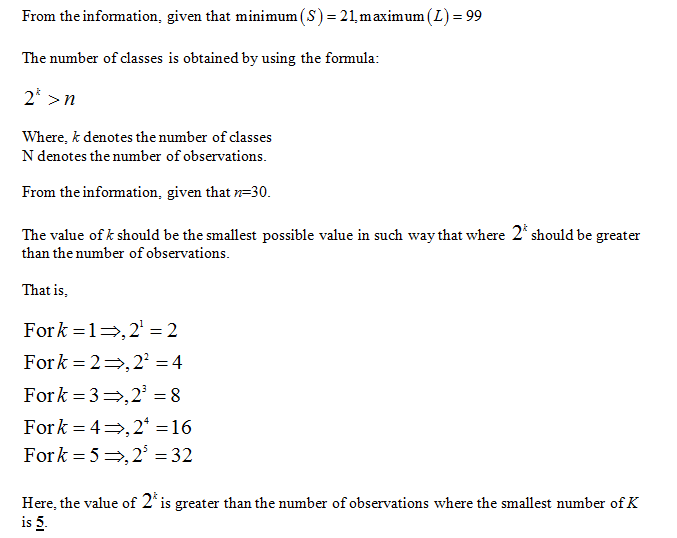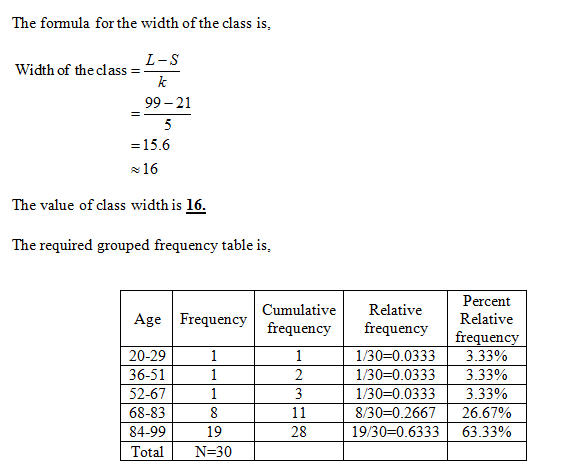Exam scores for 30 students: 21 51 64 68 70 74 77 78 81 83 83 85 87 87 87 91 92 92 92 92 93 93 94 94 94 94 95 97 98 99 a) In the space below, create a grouped frequency distribution table, using 20-29 as the first class. b) Determine the five-number summary. _________________________________ c) In space below, draw a histogram.
Inverse Normal Distribution
The method used for finding the corresponding z-critical value in a normal distribution using the known probability is said to be an inverse normal distribution. The inverse normal distribution is a continuous probability distribution with a family of two parameters.
Mean, Median, Mode
It is a descriptive summary of a data set. It can be defined by using some of the measures. The central tendencies do not provide information regarding individual data from the dataset. However, they give a summary of the data set. The central tendency or measure of central tendency is a central or typical value for a probability distribution.
Z-Scores
A z-score is a unit of measurement used in statistics to describe the position of a raw score in terms of its distance from the mean, measured with reference to standard deviation from the mean. Z-scores are useful in statistics because they allow comparison between two scores that belong to different normal distributions.
Exam scores for 30 students:
21 51 64 68 70 74 77 78 81 83 83 85 87 87 87 91 92 92 92 92 93 93 94 94 94 94 95 97 98 99
a) In the space below, create a grouped frequency distribution table, using 20-29 as
the first class.
b) Determine the five-number summary. _________________________________
c) In space below, draw a histogram.
d) In space below, draw the boxplot.
e) Identify the shape. ___________________________
f) Find the
g) Circle the correct choice: the mean is (greater; less) than the median.
h) Circle the correct choice: the (mean; median) gives the more accurate description
of overall scores.
(a)
Obtain the grouped frequency distribution table.
The grouped frequency table is obtained below as follows:

Therefore, the grouped frequency table is,

Therefore, the grouped frequency table is,

(b)
Obtain the five number summary.
The five number summary is obtained below:
Use EXCEL Procedure to obtain the value of minimum.
Follow the instruction to obtain the value of minimum.
- Open EXCEL
- Go to Formula bar.
- In formula bar enter the function as“=MIN”
- Enter the range as $A$1:$A$31.
- Click enter.
EXCEL output:
From the EXCEL output, the value of the minimum is 21.
Thus, the value of minimum is 21.
Use EXCEL Procedure to obtain the value of first quartile.
Follow the instruction to obtain the value of first quartile.
- Open EXCEL
- Go to Formula bar.
- In formula bar enter the function as“=QUARTILE”
- Enter the range as $A$1:$A$31.
- Enter the quartile as 1.
- Click enter.
EXCEL output:
From the EXCEL output, the value of the first quartile is 78.75.
Thus, the value of the first quartile is 78.75
Use EXCEL Procedure to obtain the value of second quartile.
Follow the instruction to obtain the value of second quartile.
- Open EXCEL
- Go to Formula bar.
- In formula bar enter the function as“=QUARTILE”
- Enter the range as $A$1:$A$31.
- Enter the quartile as 2.
- Click enter.
EXCEL output:
From the EXCEL output, the value of the second quartile is 89.
Thus, the value of the second quartile is 89.
Use EXCEL Procedure to obtain the value of third quartile.
Follow the instruction to obtain the value of third quartile.
- Open EXCEL
- Go to Formula bar.
- In formula bar enter the function as“=QUARTILE”
- Enter the range as $A$1:$A$31.
- Enter the quartile as 3.
- Click enter.
EXCEL output:
From the EXCEL output, the value of the third quartile is 93.75.
Thus, the value of the third quartile is 93.75.
Use EXCEL Procedure to obtain the value of maximum.
Follow the instruction to obtain the value of maximum.
- Open EXCEL
- Go to Formula bar.
- In formula bar enter the function as“=Max”
- Enter the range as $A$1:$A$31.
- Click enter.
EXCEL output:
From the EXCEL output, the value of the maximum is 99.
The value of the maximum is 99.
Step by step
Solved in 3 steps with 4 images









